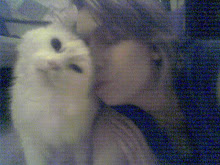Kiki's New Teaching Philosophy
I'm in the process of applying for jobs, which entails writing individualized cover letters, shifting around the order in which I present teaching and research information in my cover letter to suit the college for which I'm applying, and compiling all sorts of other documents. I had no idea it would be this time-consuming, and I've only officially applied for one job so far! In the process, I had to revisit my teaching philosophy. The first teaching philosophy I wrote can be seen here. Of course, my philosophy has changed since I've had more teaching experience. I haven't the stomach to read my old teaching philosophy; I feel I've changed so much it was written. But, I've included my new philosophy here, and if you are so inclined, you can compare the two yourself. Keep in mind that my new philosophy was written for a job teaching at a community college. Community colleges are very focused on developing excellence in teaching, and I tried to tailor my philosophy to the unique missions of community colleges. Please feel free to comment on my teaching philosophy; I'm always seeking to improve.
Much of my teaching philosophy is grounded in my research on college student retention. I find that faculty can make impressions on students that affect students’ departure decisions. If faculty can have such a profound affect on something as important as a student’s choice to continue pursuing education, then it is my duty as an educator to ensure that the impact I have on students is positive. Not only do I hope to encourage students to continue in college but I also wish to ignite in them a passion for learning and to equip them with the tools necessary to be life-long learners.
In addition, particular aspects about teaching that influence students’ departure decisions include students’ perceptions that faculty are passionate about the material they teach, care about the students they teach, and are physically and psychologically accessible to students (Lundquist, Spalding, & Landrum, 2003). Physical accessibility can easily be achieved by spending extra time in my office on campus and by responding to students’ emails and phone calls in a timely manner. Psychological accessibility can be achieved through an expression of willingness to talk with students about their needs. I endeavor to emanate an attitude of openness towards students and an eagerness to value their intellectual contributions to class. Furthermore, I highly value interacting with students inside and out of the classroom. Student-faculty interactions outside of the classroom have enormous benefits on students, including increased retention, academic achievement, satisfaction with college, intellectual and personal development, and career and educational aspirations (Lamport, 1993).
I believe I have succeeded when all my students can demonstrate learning and improvement. For example, I endeavor to foster critical thinking in students. Students do not need to be cajoled into engaging in critical thinking. They will do so if I model critical thinking as I teach, if I present material in an engaging manner, and if I foster openness towards students’ expression of their ideas. Subsequently, I find that students frequently ask me questions in class or offer critical evaluations of material we discuss in class. In order to allow students to demonstrate their critical thinking and knowledge in writing, classroom assignments include research papers and forms of evaluations include essay questions requiring application of theories and concepts.
Finally, I endeavor to engage students with the material I teach by occasionally infusing humor and real life examples into lecture content, and by including applicable demonstrations, assignments, and activities. I taught neuroscience to high school students participating in the Frontiers of Science Institute, a summer program for students interested in pursuing careers in math and science. After a unit on neuron communication and neurotransmitters, I had students take their chairs outside and line the chairs up to represent the synaptic cleft. Students took on the role of neurotransmitters and re-enacted the various neurotransmitters actions that occur during neuronal communication. My students reported that they understood the concepts more thoroughly after participating in the activity.
Building rapport with the students, interacting with students outside of class, and making a lasting educational impact on students are facets of teaching that I highly value. I welcome the opportunity to teach, advise, and mentor the students of your institution.
Labels: teaching



